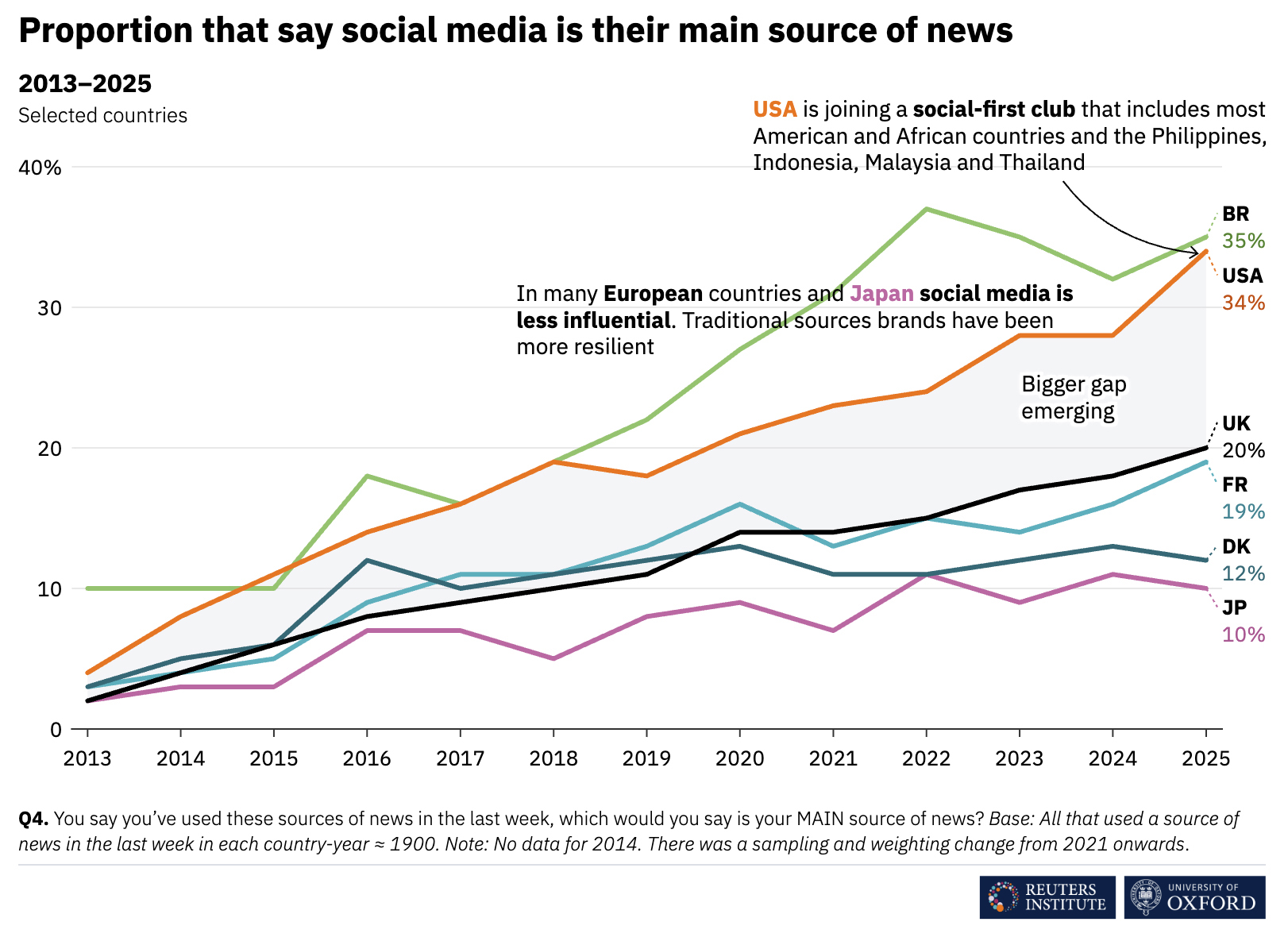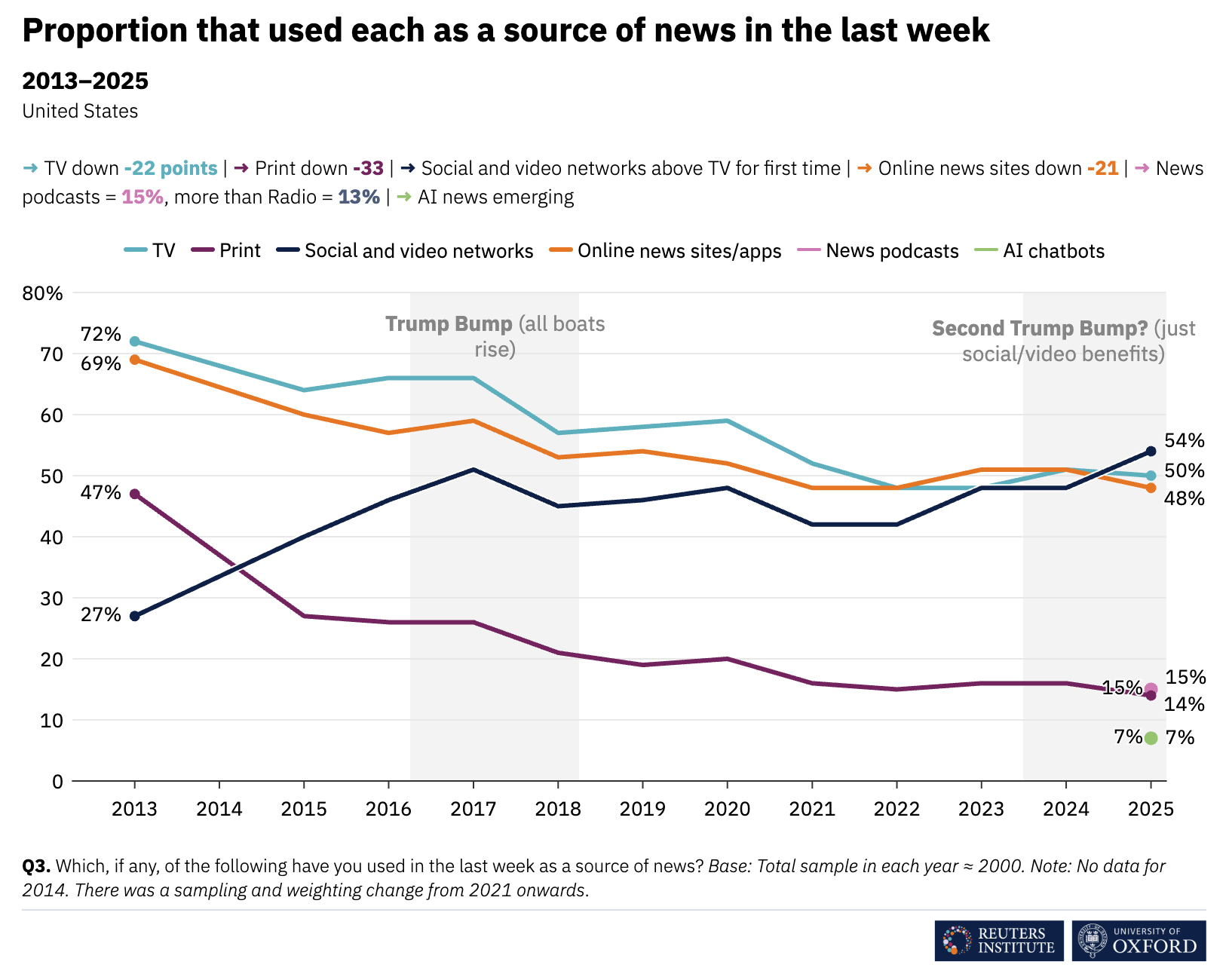Dak’s Take: Why social media’s victory over TV news is both inevitable and terrifying

Subscribe to NCS for the latest news, project case studies and product announcements in broadcast technology, creative design and engineering delivered to your inbox.
For decades, television held an unchallenged grip on America’s news habits, succeeding newspapers, which had once dominated the media landscape. Local news anchors delivered the evening news with authority, the trusted faces reassuring viewers about the state of the world.
But as Oxford’s Reuters Institute for the Study of Journalism revealed in its “2025 Digital News Report,” the inevitable has finally occurred… social media has overtaken television as Americans’ top source for news.
“Engagement with traditional media sources such as TV, print and news websites continues to fall, while dependence on social media, video platforms and online aggregators grows… Social media news use was sharply up (+6 percentage points) but there was no ‘Trump bump’ for traditional sources,” the study noted.

This shift didn’t happen overnight, but its implications reveal deeper struggles within the industry to adapt.
This isn’t just about TikTok clips or viral X threads replacing nightly news bulletins. It’s a larger reshuffling of authority, trust and the very definition of journalism itself.
RISJ found that 54% of Americans now access news through social media, eclipsing TV at 50%. That might sound incremental, but it’s a major shift given the outsized influence television has historically wielded.

But this isn’t just about platforms. It’s about personalities.
Traditional media spent decades building institutional credibility, brick by editorial brick. We created newsrooms, hired reporters, established bureaus, developed sources. We built trust through consistency, accuracy, and, yes, a certain stuffiness that signaled seriousness.
Social media threw all of that out the window and said, “What if trust wasn’t institutional but personal?”
The Reuters data notes something that should have legacy media executives brainstorming truly new ways to engage.
These creator-driven news sources are “attracting audiences that traditional media struggle to reach” – specifically young men, right-leaning audiences and those with low trust in mainstream outlets. In other words, they’re not just stealing our lunch money; they’re recruiting from the very demographics we’ve been hemorrhaging for years.
So, what’s driving this change?
It’s partly demographic, young audiences naturally gravitate to platforms where traditional media holds less sway. But this isn’t just about younger viewers. Increasingly, even older demographics, once the bulwark of TV news, are exploring digital alternatives.
Overall, the data from RISJ notes that in the U.S. between 2021 and 2025, weekly news video consumption rose significantly, reaching 72%, with substantial growth among older age groups.
Pause to reflect on that for a moment.
This isn’t merely about shifting formats, it’s a shift in who gets to shape narratives. On TikTok and YouTube, creators, often individuals without formal journalistic training, are now reaching audiences traditional newsrooms have long struggled to engage. RISJ’s data emphasizes this starkly: creators routinely outperform legacy brands on video-centric platforms, connecting especially well with audiences skeptical of mainstream news.
Take the example of Philip DeFranco, whose straightforward yet personable style has earned him millions of subscribers on YouTube. He’s successfully built trust through authenticity, underscoring RISJ’s finding that creators routinely outperform legacy brands on video-centric platforms, connecting especially well with audiences skeptical of mainstream news.
Therein lies journalism’s reckoning, the industry’s gatekeeping role has eroded.
Yet, perhaps, that’s not entirely negative. For too long, legacy media operated within self-reinforcing echo chambers, dismissing alternative viewpoints as fringe or irrelevant.
Social media’s ascendancy forces newsrooms to grapple with uncomfortable questions: Have we become disconnected from large swaths of the public? Did our definition of “newsworthiness” narrow too severely? Did the overuse of “breaking news” actually diminish the product?
Yet embracing social media wholesale isn’t without peril.
The risk of misinformation looms large. RISJ highlights an information gap, with less-educated or economically disadvantaged groups increasingly lacking clear strategies for discerning credible information. Trust in established outlets is eroding precisely among audiences who need credible journalism most.
So, what’s the path forward?
Newsrooms must reconsider their roles in a world dominated by algorithms. No longer the sole arbiters of truth, their mission shifts toward verification, context and depth.
Platforms thrive on immediacy, but journalism’s real value now lies in analysis and explanation – the kind of reporting an influencer’s viral video typically can’t provide.
Furthermore, while the pivot to video is finally, and undeniably, happening, publishers should heed past missteps. Video for video’s sake led to the last disastrous “pivot.”
This time, content must leverage what journalism excels at: credibility and contextual storytelling.
Yes, digital subscription growth has likely peaked, as RISJ points out. But this plateau should drive innovation, not despair.
Subscription fatigue indicates a demand for better value, not just more content. Bundled offerings, personalized experiences and niche coverage could sustain digital journalism’s next chapter.
The institutions most willing to question their assumptions and adapt accordingly will thrive in this evolving landscape. Journalism has always navigated disruption, and social media dominance is simply the latest storm.
As the line between news and content blurs, our collective challenge remains clear… To reaffirm journalism’s essential role as content producers and as trusted guides through a noisy, fragmented world.
Subscribe to NCS for the latest news, project case studies and product announcements in broadcast technology, creative design and engineering delivered to your inbox.






tags
Dak's Take
categories
Heroes, Journalism, Online and Digital Production, Social Media, Social Media Video Platforms, Voices